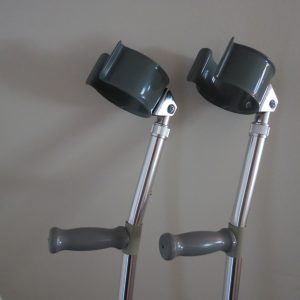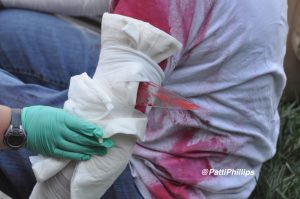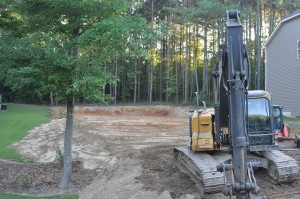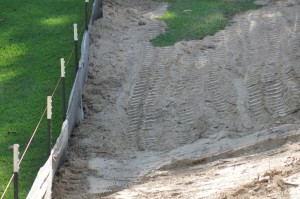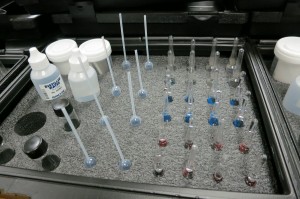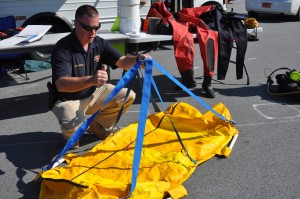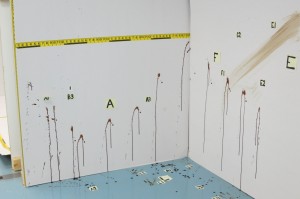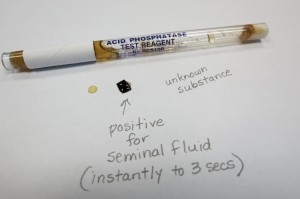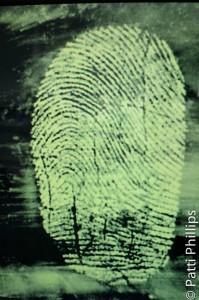KN, p. 270 “Recovery Times for On-the-Job Injuries”
The human body is a remarkable, self-contained skin, blood, water, and bones system. It has the capability of withstanding deep cuts and bruises, and even with the loss of limbs and blood, can still keep functioning. Amazing as this is, we are expected to accept on TV and in the movies that people can walk away from serious injury, take an afternoon/day off from work and get right back to the job of running after criminals and taking them down. That our heroines/heroes train a little harder than ordinary humans, face the pain in ways that mere mortals can’t, then get on with their service to the community.
Not so fast.
Yes, there is intense physical training at some of the law enforcement academies and in the special ops branches of the armed services. Physical training is included so that patrol officers will have the stamina to chase suspects up staircases and through neighborhoods without having coronaries. Special ops personnel have specialized continuous training because of the harsh conditions and challenging terrain encountered during their service around the world.
BUT, after I watched yet another 40+ year old actor ‘survive’ several jumps onto adjacent roofs a story below, continue to run after the suspect, tackle, subdue, and arrest that suspect, I rolled my eyes and questioned a couple of doctors in the know.
Repeated landings onto hard surfaces from elevations that are greater than your own height will most likely result in injury to the legs. Knees, hips, femur, tibia, fibula, ligaments, and tendons all feel the shock of repetitive pounding. Hair line cracks in the bones of legs and/or feet (as well as varicose veins) can result, even for people in their twenties. The cop may be able to chase the suspect on level ground for a few blocks if his/her cardio is in great shape, but jumping and landing from a height of more than a few feet should be followed in the books or movies by ice and/or splints and feet up for more than ten minutes. Ignore the first aid and the injury gets worse, and may result in chronic pain and/or a limp, no matter how heroic the character. Keep jumping over walls onto concrete sidewalks and an orthopedic visit will be on the schedule.
Fight scenes:
After an intense fight, there will be cuts, swelling, and bruising all over body. The body’s own natural adrenaline will carry you through the fight, but sleep, first aid, and ice packs are required to combat the ensuing pain and stiffness. Those bruises will start out as blue/purple, and as they heal will turn yellow/green. It takes about 10-14 days for the bruises to disappear, so the guys in the fight should still have some sign of the struggle on their faces or body for at least a week.
Kneecap injury: Ouch! Ligaments and tendons tear and pop and hurt A LOT! You can walk on an injured knee for weeks, but unless you like to limp, surgery is in your future. Whether minor or major surgery is part of the package, the doc will have you up and walking (with crutch, cane, or walker) the next day. There will be a load of Physical Therapy and maybe a desk job until that knee is fully recovered. (Based on my own knee surgery experiences.)
Broken bones:
A clean break in an arm requires a splint/sling to keep it more or less stable until it can be set. Recovery takes 4-6 weeks, but return to work might only take a few days because an arm is not weight-bearing.
A clean leg bone break? Depends on which bone in terms of recovery, but it could take up to 8 weeks. High on the thigh, or a compound fracture are awful breaks in terms of pain, physical therapy, and recovery, and might even be career-ending injuries. In the real world, nobody chases a suspect anytime soon on a compound fractured femur, even in a cast.
Fall through a plate glass window: the actors jump through ‘sugar glass,’ not actual glass. Anybody that gets through a plate glass window for real would have lacerations on any exposed skin, and other injuries as well, depending on the distance of the fall and what frames the glass. Most people are not big or heavy enough to break through the plate glass, but might get a concussion from collision with it.
Please note: the person in the photo was taking part in a re-enactment of a multiple injury accident scene, complete with fake blood. She was not injured in any way.
GSW (Gunshot wound): Recovery depends on where the GSW is on the body, and how severe the wound. There might be no hospital time with a couple of stitches and a light painkiller, or weeks of recovery, multiple surgeries, infection, and permanent disability.
A bullet graze is usually the equivalent of a deep cut. It hurts, but nobody is going to die from it or need an overnight stay in the hospital.
A bullet that goes through and through will hurt a great deal even if it misses vital organs. Bleeding must be stopped until help can arrive. An abdominal wound requires surgery and recovery time in bed. Holding onto your side after getting shot while you chop through the jungle with a machete ain’t happenin,’since moving increases the bleeding.
If the bullet nicks a major organ and the cop survives long enough to get to a hospital, surgery will be performed. Recovery time? Count on months away from work, not a few days.
If the bullet nicks an artery? It’s possible to bleed out in less than ten minutes (and die at the scene) before help can arrive.
My sources of information: anonymous, but include a Physical Therapist, an Orthopedic Surgeon, and active friends that have sustained a variety of injuries over the years.
KN, p. 270 “Recovery Times for On-the-Job Injuries” Read More »

